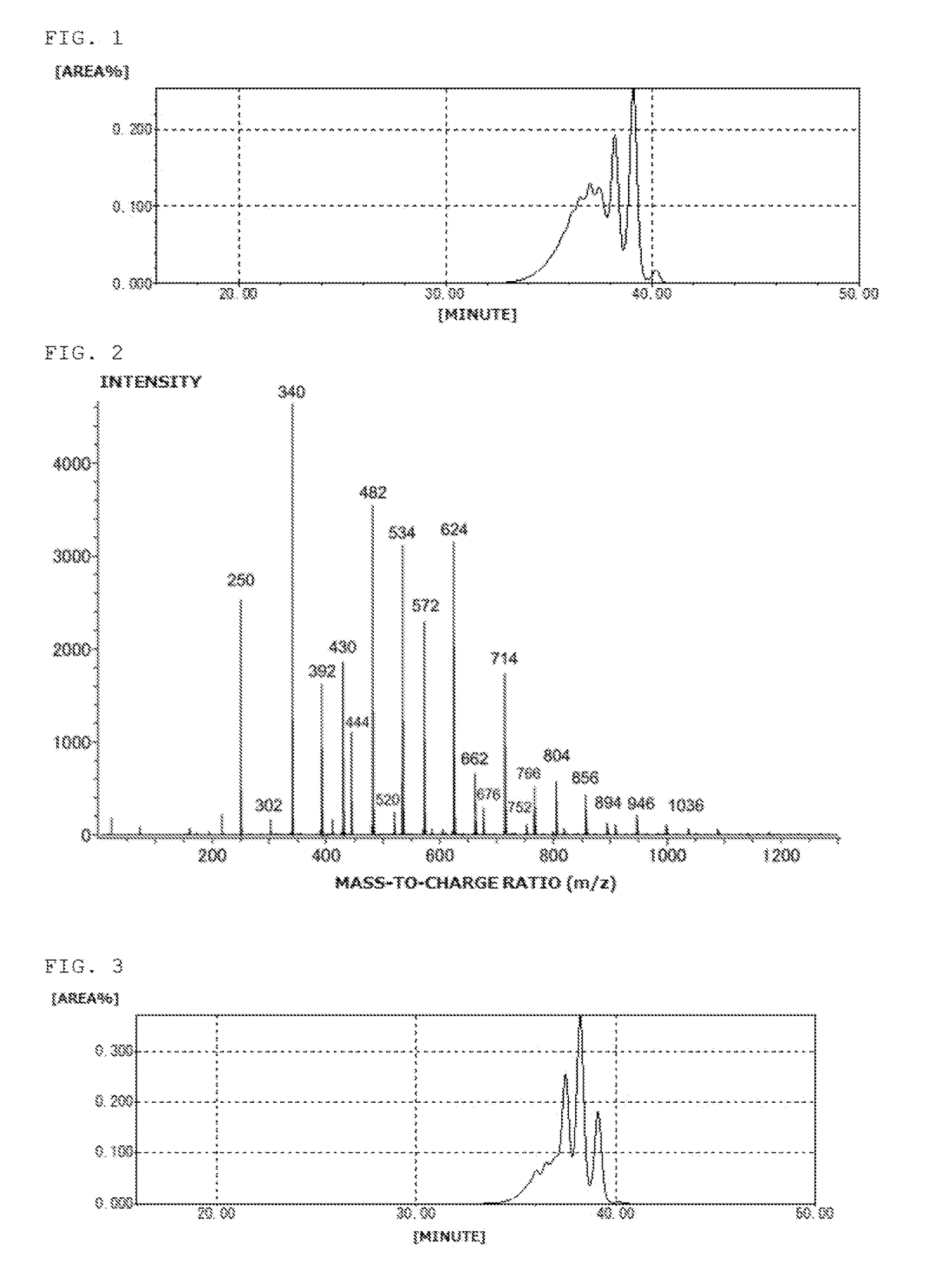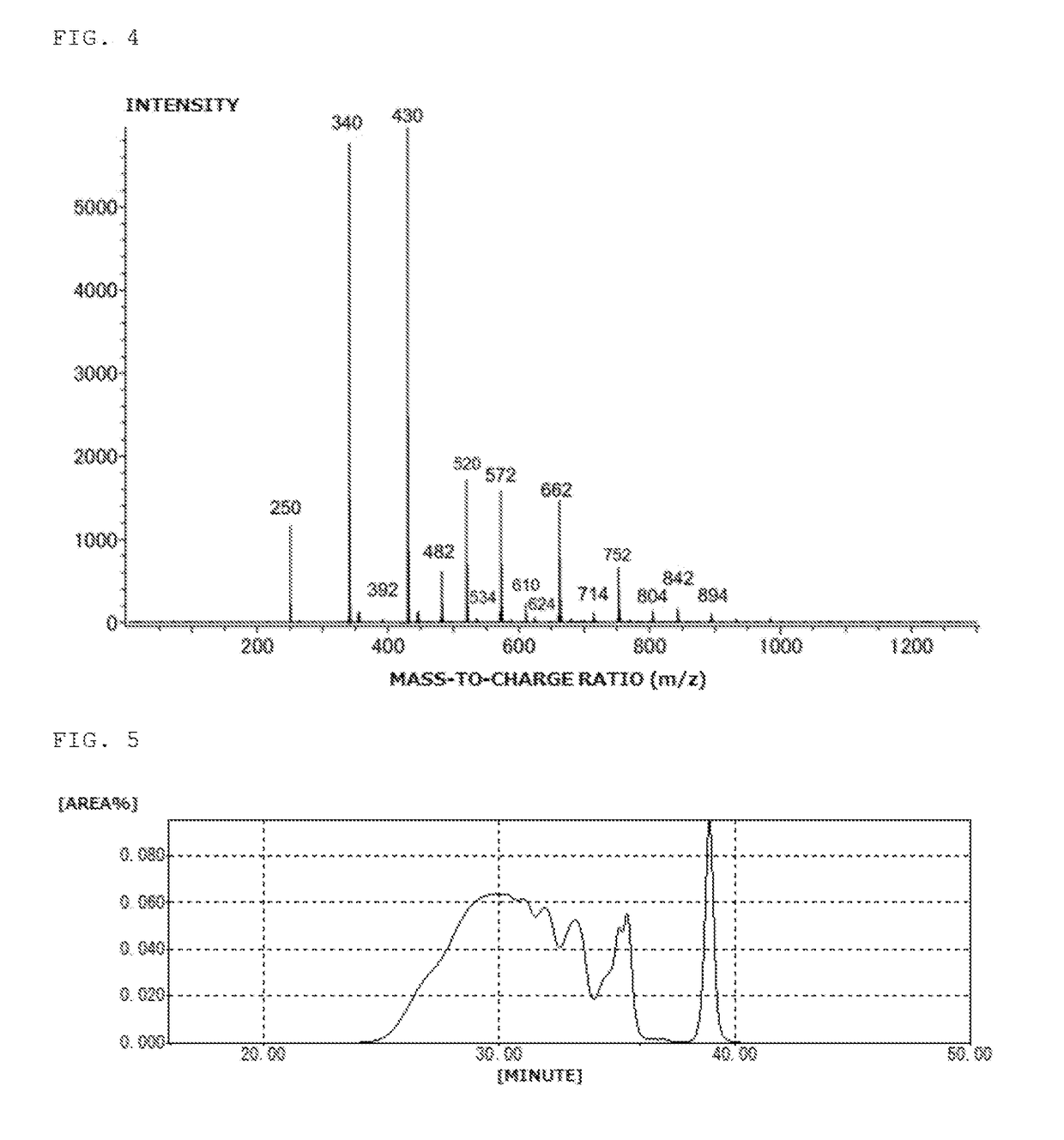Thermosetting resin composition, cured product obtained therefrom, and active ester resin for use therein
- Summary
- Abstract
- Description
- Claims
- Application Information
AI Technical Summary
Benefits of technology
Problems solved by technology
Method used
Image
Examples
synthetic example 1
[0142]Into a flask equipped with a thermometer, a dropping funnel, a condenser, a distilling column, and a stirrer, 320 g (2.0 mol) of 2,7-dihydroxynaphthalene, 184 g (1.7 mol) of benzyl alcohol, and 5.0 g of p-toluenesulfonic acid monohydrate were charged. The mixture was stirred at room temperature while blowing nitrogen. The mixture was then heated to 150° C. and stirred for 4 hours while removing the produced water to outside the system. Upon completion of the reaction, 900 g of methyl isobutyl ketone and 5.4 g of a 20% aqueous solution of sodium hydroxide were added to neutralize the mixture, the water layer was removed by separation, and the residue was washed with 280 g of water three times. Methyl isobutyl ketone was removed at a reduced pressure to obtain 460 g of a benzyl-modified naphthalene compound (A-1). The benzyl-modified naphthalene compound (A-1) was black solid, and the hydroxyl equivalent was 180 g / eq.
synthetic example 2
[0143]Into a flask equipped with a thermometer, a dropping funnel, a condenser, a distilling column, and a stirrer, 160g (1.0 mol) of 2,7-dihydroxynaphthalene, 108 g (1.0 mol) of benzyl alcohol, and 2.7 g of p-toluenesulfonic acid monohydrate were charged. The mixture was stirred at room temperature while blowing nitrogen. The mixture was then heated to 150° C. and stirred for 4 hours while removing the produced water to outside the system. Upon completion of the reaction, 500 g of methyl isobutyl ketone and 2.8 g of a 20% aqueous solution of sodium hydroxide were added to neutralize the mixture, the water layer was removed by separation, and the residue was washed with 150 g of water three times. Methyl isobutyl ketone was removed at a reduced pressure to obtain 250 g of a benzyl-modified naphthalene compound (A-2). The benzyl-modified naphthalene compound (A-2) was black solid, and the hydroxyl equivalent was 180 g / eq. The GPC chart of the benzyl-modified naphthalene compound (A-2...
synthetic example 3
[0145]Into a flask equipped with a thermometer, a dropping funnel, a condenser, a distilling column, and a stirrer, 160 g (1.0 mol) of 2,7-dihydroxynaphthalene, 216 g (2.0 mol) of benzyl alcohol, and 3.8 g of p-toluenesulfonic: acid monohydrate were charged. The mixture was stirred at room temperature while blowing nitrogen. The mixture was then heated to 150° C. and stirred for 4 hours while removing the produced wafer to outside the system. Upon completion of the reaction, 680 g of methyl isobutyl ketone and 4.0 g of a 20% aqueous solution of sodium hydroxide were added to neutralize the mixture, the water layer was removed by separation, and the residue was washed with 170 g of water three times. Methyl isobutyl ketone was removed at a reduced pressure to obtain 330 g of a benzyl-modified naphthalene compound (A-3). The benzyl-modified naphthalene compound (A-3) was black solid, and the hydroxyl equivalent was 200 g / eq. The GPC chart of the benzyl-modified naphthalene compound (A...
PUM
| Property | Measurement | Unit |
|---|---|---|
| Electrical resistance | aaaaa | aaaaa |
| Thermosetting | aaaaa | aaaaa |
| Thermal resistance | aaaaa | aaaaa |
Abstract
Description
Claims
Application Information
 Login to View More
Login to View More - R&D
- Intellectual Property
- Life Sciences
- Materials
- Tech Scout
- Unparalleled Data Quality
- Higher Quality Content
- 60% Fewer Hallucinations
Browse by: Latest US Patents, China's latest patents, Technical Efficacy Thesaurus, Application Domain, Technology Topic, Popular Technical Reports.
© 2025 PatSnap. All rights reserved.Legal|Privacy policy|Modern Slavery Act Transparency Statement|Sitemap|About US| Contact US: help@patsnap.com



